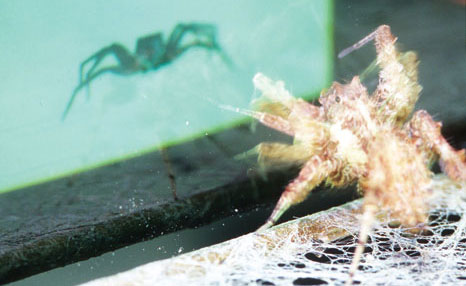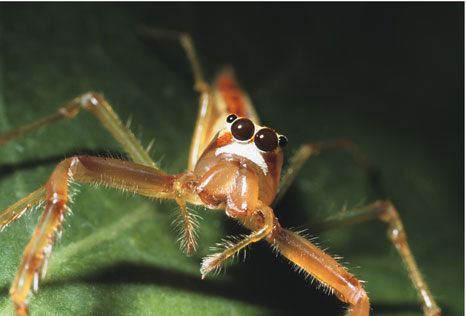 |
|
|||
Click here to view all Upcoming Events// IFF Directors Talks
IFF Directors Talks 2012 // Previous IFF Lectures THE MOSELY SNOWFLAKE SPONGE THE ART OF ITERATION MAKING SPACE IFF Director Margaret Wertheim speaks at Art Center College of Design Captain Charles Moore Talks About Plastic Trash IFF Director Margaret Wertheim Seeing Anew [IFF-L20] Structural Considerations of the Business Card
Sponge[IFF-L17] Where the Wild Things Are 2: Things That Think: Where the Wild Things Are: Crocheting the Hyperbolic Plane: Darwinism on a Desktop: The Logic Alphabet Why Things Don't Fall Down Kindergarten: Crocheting the Hyperbolic Plane [IFF-L5] The Mathematics of Paper Folding [IFF-L4] The Physics of Snowflakes [IFF-L3] Crocheting the Hyperbolic Plane [IFF-L2] The Figure That Stands Behind Figures: // Previous Events Crochet Hyperbolic Workshop
|
The
Institute for Figuring |
|||
 |
||||
| A jumping spider watching a cartoon spider on TV attacks the virtual competitor as fiercely as if it were the real thing. Photo courtesy Dr. Duane Harland. | ||||
|
|
||||

|
||||
A Singaporean jumping spider. Two front facing eyes are complemented by two other sets of eyes that allow the animal to see in 360 degree panoramic scope. Here, 4 of the 6 eyes are visible. Photo courtesy Dr Simon Pollard. |
||||
|
Everything about a jumping spider’s vision
system demands our admiration – beginning with the number
of eyes. In addition to two forward facing lenses that jut out on
stalks from the front of its head, a jumping spider has four peripheral
eyes that enable it to see at the back of its head. The two front
eyes operate on the same principle as a Galilean telescope, the
result of the same evolutionary strategy to that taken by eagles
and falcons. Information from all six eyes is processed by a brain
that contains just a few hundred thousand neurons yet is capable
of recognizing television pictures. In this lecture, Dr Simon Pollard
will talk about the physics, neurology and perceptual psychology
of how a spider sees the world. |
||||
 |
||||
|
Jumping spider of the species evarcha,
sizing up a mosquito lure. All spiders are liquid feeders - they
must liquify a meal before they can eat it. Most spiders do this
by pumping their own stomach juices into the prey turning it into
an extension of their own guts. Evarcha gets around this step by
siphoning blood directly from the stomach of a freshly engorged
mosquito. Photo courtesy Dr Simon Pollard. |
||||
|
Dr Simon Pollard has been studying vision-based cognition in arachnids for over 25 years. In 2003 he and fellow New Zealander Dr Robert Jackson discovered a new species of jumping spider – evarcha – that feeds on the contents of a mosquito’s stomach. Pollard is Curator of Invertebrate Zoology at the Canterbury Museum in Christchurch. The event will include films of spiders watching television and a screening of cartoons made specifically for an arachnid audience. THE INSECT TRILOGY |
||||
| © 2003–2018 The Institute For Figuring | ||||